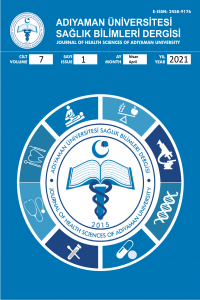Prokalsitonin Düzeyleri ile Koroner Yavaş Akım Arasındaki İlişki.
koroner yavaş akım, prokalsitonin, CRP
The Relationship Between Procalcitonin Levels and Coronary Slow Flow.
coronary slow flow, procalcitonin, CRP,
___
- 1. Tambe AA, Demany MA, Zimmerman HA, et al. Angina pectoris and slow flow velocity of dye in coronary arteries--a new angiographic finding. Am Heart J. 1972 Jul;84(1):66–71.
- 2. Sezgin AT, Sgrc A, Barutcu I, et al. Vascular endothelial function in patients with slow coronary flow. Coron Artery Dis. 2003;14(2):155–161.
- 3. Pekdemir H, Cin VG, Çiçek D, et al. Slow coronary flow may be a sign of diffuse atherosclerosis. Contribution of FFR and IVUS. Acta Cardiol. 2004;59(2):127–33.
- 4. Horjeti B, Goda A. Acute ischemia manifestation in a patient with coronary slow flow phenomenon. J Electrocardiol. 2012;45(3):277–9.
- 5. Wożakowska-Kapłon B, Niedziela J, Krzyżak P, et al. Clinical manifestations of slow coronary flow from acute coronary syndrome to serious arrhythmias. Cardiol J. 2009;16(5):462–8.
- 6. Kalay N, Aytekin M, Kaya MG, et al. The relationship between inflammation and slow coronary flow: increased red cell distribution width and serum uric acid levels. Arch Turk Soc Cardiol. 2011;39(6):463–8.
- 7. Ross R. 011499 Atherosclerosis -- An Inflammatory Disease. N Engl J Med. 1999;12.
- 8. Haverkate E, Thompson SG, Pyke SD, et al. Production of C-reactive protein and risk of coronary events in stable and unstable angina. The Lancet. 1997 Feb 15;349(9050):462–6.
- 9. Assicot M, Bohuon C, Gendrel D, et al. High serum procalcitonin concentrations in patients with sepsis and infection. The Lancet. 1993 Feb 27;341(8844):515–8.
- 10. Whicher J, Bienvenu J, Monneret G. Procalcitonin as an Acute Phase Marker. Ann Clin Biochem. :11.
- 11. Kafkas N, Venetsanou K, Patsilinakos S, et al. Procalcitonin in acute myocardial infarction. Acute Card Care. 2008 Jan 1;10(1):30–6.
- 12. Ataoğlu H, Yilmaz F, Uzunhasan I, et al. Procalcitonin: A Novel Cardiac Marker with Prognostic Value in Acute Coronary Syndrome. J Int Med Res. 2010 Feb;38(1):52–61.
- 13. Gibson CM, Cannon CP, Daley WL, et al. TIMI frame count: a quantitative method of assessing coronary artery flow. Circulation. 1996 Mar 1;93(5):879–88.
- 14. de Werra I, Jaccard C, Corradin SB, et al. Cytokines, nitrite/nitrate, soluble tumor necrosis factor receptors, and procalcitonin concentrations: Comparisons in patients with septic shock, cardiogenic shock, and bacterial pneumonia. Crit Care Med. 1997 Apr;25(4):607.
- 15. Buratti T, Ricevuti G, Pechlaner C, et al. Plasma Levels of Procalcitonin and Interleukin-6 in Acute Myocardial Infarction. Inflammation. 2001 Apr 1;25(2):97–100.
- 16. Ilhan F, Akbulut H, Karaca I, et al. Procalcitonin, c-reactive protein and neopterin levels in patients with coronary atherosclerosis. Acta Cardiol. 2005 Aug 1;60(4):361–5.
- 17. Erren M, Reinecke H, Junker R, et al. Systemic inflammatory parameters in patients with atherosclerosis of the coronary and peripheral arteries. Arterioscler Thromb Vasc Biol. 1999 Oct;19(10):2355–63.
- 18. Sinning CR, Sinning J-M, Schulz A, et al. Association of serum procalcitonin with cardiovascular prognosis in coronary artery disease. Circ J Off J Jpn Circ Soc. 2011;75(5):1184–91.
- 19. Murat SN, Kurtul A, Celik IE, et al. The association of serum procalcitonin level with the no-reflow phenomenon after a primary percutaneous coronary intervention in patients with ST-elevation myocardial infarction. Coron Artery Dis. 2016 Mar;27(2):116–21.
- 20. Kurtul A, Elcik D. Procalcitonin is an independent predictor for coronary atherosclerotic burden in patients with stable coronary artery disease. Int J Cardiol. 2017 Jun 1;236:61–4.
- 21. Tunay Şentürk, Cordan J, Baran I, et al. Procalcitonin in patients with acute coronary syndrome: correlation with high-sensitive C-reactive protein, prognosis and severity of coronary artery disease. Acta Cardiol. 2007 Apr 1;62(2):135–41.
- 22. Ferreirós ER, Boissonnet CP, Pizarro R, et al. Independent prognostic value of elevated C-reactive protein in unstable angina. Circulation. 1999 Nov 9;100(19):1958–63.
- 23. Liuzzo G, Biasucci LM, Gallimore JR, et al. The Prognostic Value of C-Reactive Protein and Serum Amyloid A Protein in Severe Unstable Angina. N Engl J Med. 1994 Aug 18;331(7):417–24.
- 24. Mangieri E, Macchiarelli G, Ciavolella M, et al. Slow coronary flow: Clinical and histopathological features in patients with otherwise normal epicardial coronary arteries. Cathet Cardiovasc Diagn. 1996;37(4):375–81.
- 25. Mosseri M, Yarom R, Gotsman MS, et al. Histologic evidence for small-vessel coronary artery disease in patients with angina pectoris and patent large coronary arteries. Circulation. 1986 Nov;74(5):964–72.
- 26. Antoniades C, Tousoulis D, Vasiliadou C, et al. Combined effects of smoking and hypercholesterolemia on inflammatory process, thrombosis/fibrinolysis system, and forearm hyperemic response. Am J Cardiol. 2004 Nov 1;94(9):1181–4.
- 27. Xia S, Deng S-B, Wang Y, et al. Clinical analysis of the risk factors of slow coronary flow. Heart Vessels. 2011 Sep 1;26(5):480–6.
- 28. Selcuk H, Maden O, Selcuk MT, et al. Documentation of impaired coronary blood flow in chronic obstructive pulmonary disease patients. Circ J Off J Jpn Circ Soc. 2010 Feb;74(2):346–52.
- 29. Li J-J, Qin X-W, Li Z-C, et al. Increased plasma C-reactive protein and interleukin-6 concentrations in patients with slow coronary flow. Clin Chim Acta. 2007 Oct 1;385(1):43–7.
- 30. Cetin M, Zencir C, Tasolar H, et al. The association of serum albumin with coronary slow flow. Wien Klin Wochenschr. 2014 Aug 1;126(15):468–73.
- Yayın Aralığı: Yılda 3 Sayı
- Başlangıç: 2015
- Yayıncı: ADIYAMAN ÜNİVERSİTESİ
Is there any association between ABO blood types and slow coronary flow?
Metal para yutma sonrası gelişen özofagus perforasyonu ve şilotoraksın tedavisi
Herpetik Geometrik Glossit Olgusu: Nadir Oral Herpetik Görünüm
Sibel ALTUNIŞIK TOPLU, Nihal ALTUNIŞIK, Yaşar Bayındır YAŞAR BAYINDIR
MIDAZOLAM'IN MORFİNE İLİŞKİN MODÜLASYON ETKİSİ ANTİNOKİKASYON ZAMANI BAĞIMLI MI?
Seyfullah Oktay ARSLAN, İşıl ÖZKOÇAK TURAN
Vernal Keratokonjonktivit Hastalarında Kırmızı Hücre Dağılım Genişliğinin Değerlendirilmesi
Ali ŞİMŞEK, Lokman BALYEN, Müslüm TOPTAN, Ayhan SAĞLAR, Ali Asgar YETKİN
Şeyho Cem YÜCETAŞ, Necati ÜÇLER, Safiye Kafadar, Süleyman KILINÇ, M. Fuat TORUN
Prokalsitonin Düzeyleri ile Koroner Yavaş Akım Arasındaki İlişki.
Ramazan Asoğlu, Hakan Kaya, Emin Asoğlu, Abdülmecid Afşin, Arif Süner
